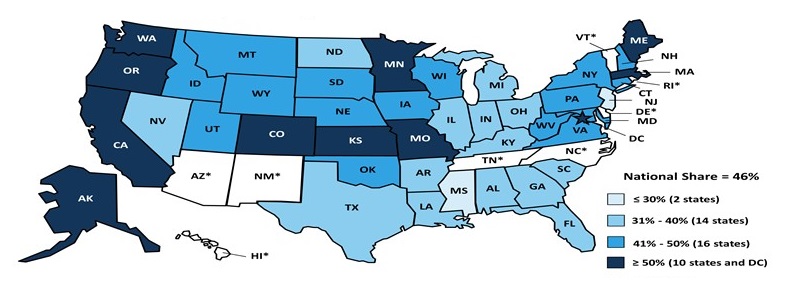Tuesday, November 10, 2020
Printer Friendly Version in PDF Format (5 PDF pages)
Expanding Access to LTSS for People Living with ADRD and their Caregivers
Debra L Cherry, PhD
Executive VP, Alzheimer's Los Angeles and Chairperson, NAPA LTSS Subcommittee
Long Term Care Needs
- Levels of LTSS
- Individual
- Family
- Community
- Residential
- Caregivers
- Identify and document
- Assess needs and levels of stress
- Engage in person and family-centered care planning, consistent with "person's" wishes
- Provide disease education and support that is culturally and literacy-level appropriate
- Connect to community-based resources
Gaps and Barriers to Access
- Workforce
- Service delivery
- Affordability
- For socio-economically, racially and ethnically diverse populations
- Cultural
- Linguistic
- Literacy level
- Access to technology -- wi-fi, computers and tech-savvy
- Cost
- https://www.alzheimersla.org/?s=tip+sheets
Who pays for LTSS?
- Public Sources Outweigh Private
- Medicare
- Medicaid
- LTC Insurance
- Other (Managed Care and Unions)
- Out of Pocket Costs
 |
| SOURCE: Health Affairs, 2017; : National Health Expenditures Data, 2015. Centers for Medicare and Medicaid Services. https://www.cms.gov/Research-Statistics-Data-and-Systems/Statistics-Trends-and-Reports/NationalHealthExpendData/Downloads/Tables.zip |
How expensive are LTSS?
- These costs can impoverish a middle-class family.
- The average retirement savings for baby boomers is about $75,000 while the cost of providing LTSS is significant. In 2017, the average annual cost of a community-based adult day-care center was $16,900; a home health aide was $49,000; and the cost to live in a nursing facility was $97,455.
American Medical Assn., 2018
- The average retirement savings for baby boomers is about $75,000 while the cost of providing LTSS is significant. In 2017, the average annual cost of a community-based adult day-care center was $16,900; a home health aide was $49,000; and the cost to live in a nursing facility was $97,455.
Who pays for LTSS?
- For Lower Income Families, Medicaid Spending on LTSS and the Available Benefits Vary by State
| Figure 4. The Proportion of Medicaid Long-Term Services and Supports Spending For Home and Community-Based Services Varies by State, 2013 |
|---|
 |
| SOURCE: Urban Institute estimates based on data from CMS Form 64 as of September 2014. NOTE: All spending includes state and federal expenditures. HCBS expenditures include state plan home health services, state plan personal care, targeted case management, hospice, home and community-based care for the functionally-disabled elderly, and services provided under HCBS waivers. Expenditures do not include administrative costs, accounting adjustments, or expenditures in the U.S. territories. * Spending for AZ, DE, HI, NC, NM, RI, TN, and VT is not shown due to their funding authority for HCBS and/or the way spending is reported. |
Impact of COVID-19 on LTSS for People Living with ADRD and their Caregivers
- Individuals, Families and Providers are Challenged
- "In England and Wales, 25% of those who died from the virus had dementia"
The Economist, August 3, 2020 - "At least 15,000 more Americans have died in recent months from Alzheimer's disease and dementia than otherwise would have ..."
The Wall Street Journal, June 28, 2020 - Most adult day centers are closed
- Many families fear bringing a worker into the home
- Many services are offered online, but are not accessible to all
- "In England and Wales, 25% of those who died from the virus had dementia"
Learning from the Past to Inform Future NAPA Recommendations
- Venoreen Browne-Boatswain -- Lived experience
- Gretchen Alkema -- Where we've been
- Panel: Where states are now and suggestions for the future
- Moderated by Carrie Molke
- Speakers: Marc Cohn, Center for Consumer Engagement in Healthcare Innovation
Martha Roherty, Advancing States
Kitty Purrington, National Academy for State Health Policy
Jenn Rosen, Alzheimer's Association
- Vignettes: Effective ACL-funded models for increasing access to HCBS for ethnically diverse groups
- Moderated by Maria Ordonez
- Featuring: Madeline Michel, Haitian Memory Cafe
Constantina Mizis, Promotores de Salud
- Gretchen Alkema -- Future directions and recommended strategies
